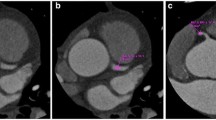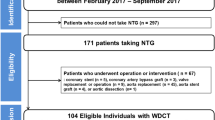Abstract
Helical prospective ECG-gating (pECG) may reduce radiation dose while maintaining the advantages of helical image acquisition for coronary computed tomography angiography (CCTA). Aim of this study was to evaluate helical pECG–gating in CCTA in regards to radiation dose and image quality. 86 patients undergoing 64-multislice CCTA were enrolled. pECG-gating was performed in patients with regular heart rates (HR) < 65 bpm; with the gating window set at 70–85% of the cardiac cycle. All patients received oral and some received additional IV beta-blockers to achieve HR < 65 bpm. In patients with higher or irregular HR, or for functional evaluation, retrospective ECG-gating (rECG) was performed. The average X-ray dose was estimated from the dose length product. Each arterial segment (modified AHA/ACC 17-segment-model) was evaluated on a 4-point image quality scale (4 = excellent; 3 = good, mild artefact; 2 = acceptable, some artefact, 1 = uninterpretable). pECG-gating was applied in 57 patients, rECG-gating in 29 patients. There was no difference in age, gender, body mass index, scan length or tube output settings between both groups. HR in the pECG-group was 54.7 bpm (range, 43–64). The effective radiation dose was significantly lower for patients scanned with pECG-gating with mean 6.9 mSv ± 1.9 (range, 2.9–10.7) compared to rECG with 16.9 mSv ± 4.1 (P < 0.001), resulting in a mean dose reduction of 59.2%. For pECG-gating, out of 969 coronary segments, 99.3% were interpretable. Image quality was excellent in 90.2%, good in 7.8%, acceptable in 1.3% and non-interpretable in 0.7% (n = 7 segments). For patients with steady heart rates <65 bpm, helical prospective ECG-gating can significantly lower the radiation dose while maintaining high image quality.




Similar content being viewed by others
Abbreviations
- CT:
-
Computed tomography
- CCTA:
-
Cardiac computed tomography angiography
- ECG:
-
Electrocardiogramm
- bpm:
-
Beats per minute
- pECG:
-
Prospective ECG-gating
- rECG:
-
Retrospective ECG-gating
References
Budoff MJ, Dowe D, Jollis JG, Gitter M, Sutherland J, Halamert E, Scherer M, Bellinger R, Martin A, Benton R, Delago A, Min JK (2008) Diagnostic performance of 64-multidetector row coronary computed tomographic angiography for evaluation of coronary artery stenosis in individuals without known coronary artery disease: results from the prospective multicenter ACCURACY (assessment by Coronary computed tomographic angiography of individuals undergoing invasive coronary angiography) trial. J Am Coll Cardiol 52(21):1724–1732
Mowatt G, Cummins E, Waugh N, Walker S, Cook J, Jia X, Hillis GS, Fraser C (2008) Systematic review of the clinical effectiveness and cost-effectiveness of 64-slice or higher computed tomography angiography as alternative to invasive coronary angiography in the investigation of coronary artery disease. Health Technol Assess 12(17):iii–iv, ix–143
Einstein AJ, Henzlova MJ, Rajagopalan S (2007) Estimating risk of cancer associated with radiation exposure from 64-slice computed tomography coronary angiography. JAMA 298(3):317–323
Hausleiter J, Meyer T, Hadamitzky M et al (2006) Radiation dose estimates from cardiac multislice computed tomography in daily practice: impact of different scanning protocols on effective dose estimates. Circulation. 113:1305–1310
Mollet N, Cademartiri F, van Mieghem C, Runza G, McFadden EP, Baks T, Serruys PW, Krestin GP, de Feyter PJ (2005) High-resolution spiral computed tomography coronary angiography in patients referred for diagnostic conventional coronary angiography. Circulation 112:2318–2323
Jakobs TF, Becker CR, Ohnesorge B, Flohr T, Suess C, Schoepf UJ, Reiser MF (2002) Multislice helical CT of the heart with retrospective ECG gating: reduction of radiation exposure by ECG-controlled tube current modulation. Eur Radiol 12(5):1081–1086
Hermann F, Martinoff S, Meyert T et al (2008) Reduction of radiation dose estimates in cardiac 64-slice CT angiography in patients after coronary artery bypass graft surgery. Invest Radiol 43(4):253–260
Earls JP, Berman EL, Urban BA, Curry CA, Lane JL, Jennings RS, McCulloch CC, Hsieh J, Londt JH (2008) Prospectively gated transverse coronary CT angiography versus retrospectively gated helical technique: improved image quality and reduced radiation dose. Radiology 246(3):742–753
Hirai N, Horiguchi J, Fujioka C, Kiguchi M, Yamamoto H, Matsuura N, Kitagawa T, Teragawa H, Kohno N, Ito K (2008) Prospective versus retrospective ECG-gated 64-detector coronary CT angiography: assessment of image quality, stenosis, and radiation dose. Radiology 248(2):424–430
Shuman WP, Branch KR, May JM, Mitsumori LM, Lockhart DW, Dubinsky TJ, Warren BH, Caldwell JH (2008) Prospective versus retrospective ECG gating for 64-detector CT of the coronary arteries: comparison of image quality and patient radiation dose. Radiology. 248(2):431–437
Scheffel H, Alkadhi H, Leschka S, Plass A, Desbiolles L, Guber I, Krauss T, Gruenenfelder J, Genoni M, Luescher TF, Marincek B, Stolzmann P (2008) Low-dose ct coronary angiography in the step-and-shoot mode: diagnostic performance. Heart. 2008 [Epub ahead of print]
Stolzmann P, Leschka S, Scheffel H, Krauss T, Desbiolles L, Plass A, Genoni M, Flohr TG, Wildermuth S, Marincek B, Alkadhi H (2008) Dual-source CT in step-and-shoot mode: noninvasive coronary angiography with low radiation dose. Radiology 249(1):71–80
Hendel RC, Patel MR, Cramer CM (2006) et al. ACCF/ACR/SCCT/SCMR/ASNC/NASCI/SCAI/SIR 2006. Appropriateness criteria for cardiac computed tomography and cardiac magnetic resonance imaging. J Am Coll Cardiol 48:1475–1497
Menzel HG, Schibilla H, Teunen D eds (2000) European guidelines on quality criteria for computed tomography. Luxembourg: European Commission. Publication No. EUR 16262 EN. Appendix I: guidelines on radiation dose to the patient
Landis J, Koch G (1977) The measurement of observer agreement with categorical data. Biometrics 33:159–174
Austen WG, Edwards JE, Frye RL, Gensini GG, Gott VL, Griffith LS, McGoon DC, Murphy ML, Roe BB (1975) A reporting system on patients evaluated for coronary artery disease: report of the Ad Hoc committee for grading of coronary artery disease, Council on cardiovascular surgery, American heart association. Circulation. 51:5–40
Maruyama T, Takada M, Hasuike T, Yoshikawa A, Namimatsu E, Yoshizumi T (2008) Radiation dose reduction and coronary assessability of prospective electrocardiogram-gated computed tomography coronary angiography: comparison with retrospective electrocardiogram-gated helical scan. J Am Coll Cardiol 52:1450–1455
Stolzmann P, Scheffel H, Schertler T et al (2008) Radiation dose estimates in dual-source computed tomography coronary angiography. Eur Radiol 18:592–599
Leschka S, Stolzmann P, Schmid FT, Scheffel H, Stinn B, Marincek B, Alkadhi H, Wildermuth S (2008) Low kilovoltage cardiac dual-source CT: attenuation, noise, and radiation dose. Eur Radiol 18(9):1809–1817
Feuchtner GM, Jodocy D, Klauser A et al (2009) Radiation dose reduction by using 100-kV tube voltage in cardiac 64-slice computed tomography: a comparative study. Eur J Radiol. doi:10.1016/j.ejrad.2009.07.012
Gutstein A, Dey D, Cheng V et al (2008) Algorithm for radiation dose reduction with helical dual source coronary computed tomography angiography in clinical practice. J Cardiovasc Comput Tomogr 2(5):311–322
Barreto M, Schoenhagen P, Nair A et al (2008) Potential of dual-energy computed tomography to characterize atherosclerotic plaque: ex vivo assessment of human coronary arteries in comparison to histology. J Cardiovasc Comput Tomogr 2(5):234–242
Alkadhi H, Stolzmann P, Scheffel H, Desbiolles L, Baumüller S, Plass A, Genoni M, Marincek B, Leschka S (2008) Radiation dose of cardiac dual-source CT: the effect of tailoring the protocol to patient-specific parameters. Eur J Radiol 68(3):385–391
Cury RC, Nieman K, Shapiro MD, Butler J, Nomura CH, Ferencik M, Hoffmann U, Abbara S, Jassal DS, Yasuda T, Gold HK, Jang IK, Brady TJ (2008) Comprehensive assessment of myocardial perfusion defects, regional wall motion, and left ventricular function by using 64-section multidetector CT. Radiology. 248(2):466–475
Feuchtner GM, Dichtl W, Friedrich GJ et al (2006) Multislice computed tomography for detection of patients with aortic valve stenosis and quantification of severity. J Am Coll Cardiol 47:1410–1417
Feuchtner GM, Dichtl W, Müller S, Jodocy D, Schachner T, Klauser A, Bonatti JO (2008) 64-MDCT for diagnosis of aortic regurgitation in patients referred to CT coronary angiography. AJR Am J Roentgenol 191(1):W1–W7
Leschka S, Stolzmann P, Desbiolles L, Baumueller S, Goetti R, Schertler T, Scheffel H, Plass A, Falk V, Feuchtner G, Marincek B, Alkadhi H (2009) Diagnostic accuracy of high-pitch dual-source CT for the assessment of coronary stenoses: first experience. Eur Radiol (in press)
Lell M, Marwan M, Schepis T, Pflederer T, Anders K, Flohr T, Allmendinger T, Kalender W, Ertel D, Thierfelder C, Kuettner A, Ropers D, Daniel WG, Achenbach S (2009) Prospectively ECG-triggered high-pitch spiral acquisition for coronary CT angiography using dual source CT: technique and initial experience. Eur Radiol [Epub ahead of print]
Acknowledgments
Conflict of interest statement
TD is member of the Speakers Bureau for Toshiba Medical Systems.
Author information
Authors and Affiliations
Corresponding author
Rights and permissions
About this article
Cite this article
DeFrance, T., Dubois, E., Gebow, D. et al. Helical prospective ECG-gating in cardiac computed tomography: radiation dose and image quality. Int J Cardiovasc Imaging 26, 99–107 (2010). https://doi.org/10.1007/s10554-009-9522-6
Received:
Accepted:
Published:
Issue Date:
DOI: https://doi.org/10.1007/s10554-009-9522-6




